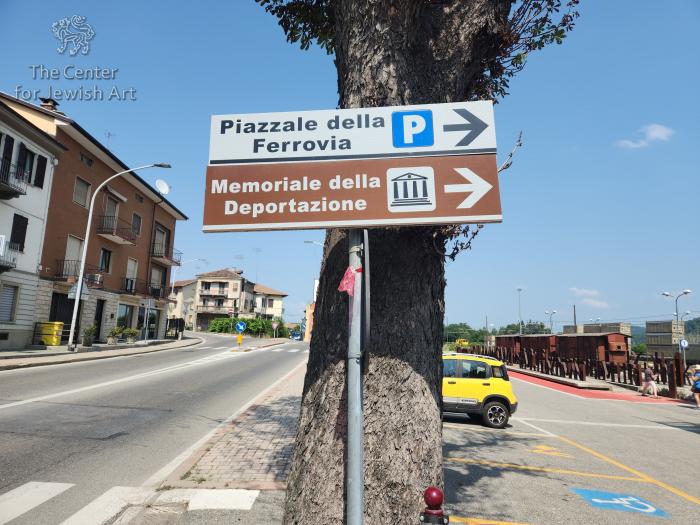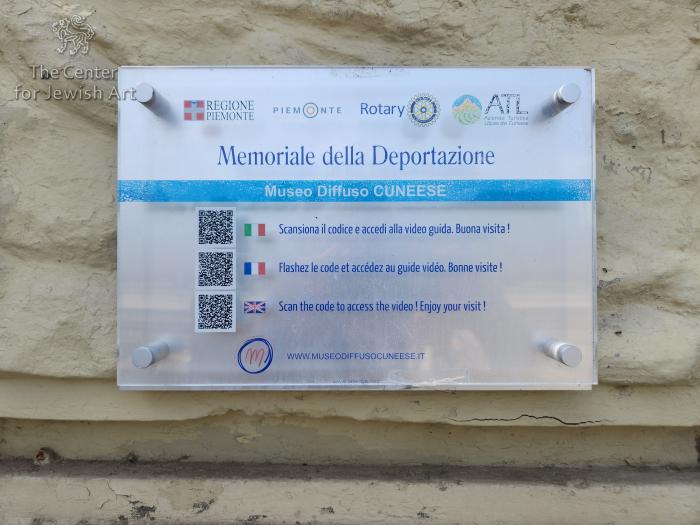Obj. ID: 53313 Holocaust memorial in Borgo San Dalmazzo, Italy, 2006

Name of Monument
Memoriale della Depotazione
Translation: Deportation Memorial
Who/What is Commemorated?
355 Jews deported from Borgo San Dlamazzo
Description
The memorial occupies a large space adjoining the train station of Borgo San Dalmazzo. A long red strip on the pavement leads from the station to the access ramp of the memorial where there is a plaque explaining its purpose, the history of the deportation, and listing the names of those who worked on the project.
The memorial consists of a concrete slab set slightly above ground level that provides a platform for the three train Wagons (cars) installed close to the present-day railroad tracks. The train wagons are accessible to the public, but only one has a ramp for those with physical disabilities. The platform is surrounded by rocks of different sizes.
On the platform in front of the train cars – facing the town – are the names of 20 survivors spelled out in large three-dimensional letters in corten steel. Set in the concrete ground of the platform are steel plates are the names, ages, and nationalities of the 335 deportees who were transported and murdered. The names are arranged to show the relations between the deportees.
Each prisoner is identified by name, age, and nationality as recorded in the camp register. Each family group is separated from the next by an un-cut strip of metal. All the words are written in metal, which over time, will become the same reddish-brown color as the freight wagons, caused by oxidation.
The memorial is lit by spotlights positioned at the base of the name pillar of each survivor. At night, a series of hidden lights give the illusion that the base is lightly raised with respect to the ground. The train wagons are illuminated at the base by a series of lights placed in the ground to highlight their presence.
The memorial is situated between the train line and the main road that leads to the French border from Cuneo; it is highly visible and accessible to the public at all times.
Inscriptions
The monument inscriptions are the names, dates, and nationalities of the deported.
Città di Borgo San Dalmazzo - medaglia d’oro al merito civile
Memoriale della deportazione
In 21 novembre 1943 e il 15 febbraio 1944 furono ammassate sul piazzale della stazione ferroviaria di Borgo San Dalmazzo 355 persone, uomini, donne, bambini, che, fatti salire sui vagoni merci, furono condotti ai campi di stermino di Auschwitz e Buchenwald, dove 335 di loro furono uccisi. Erano ebrei, italiani e stranieri, rinchiusi in precedenze nel campo di raccolta allestito poco lontano.
Quei segni di silenzio d’[?]assenza ti diranno quanto male può provocare
l’uomo, quando accetta che i diritti[?] di un altro siano inferiori ai suoi.
Translation: The city of Borgo San Dalmazzo - golden medal for civil merit // The deportation memorial // On 21 November 1943 and 15 February 1944, 335 people - men, women, children - were assembled on the railway station square of Borgo San Dalmazzo, boarded into freight wagons, brought to the extermination camps of Auschwitz and Buchenwald, where 335 of them were killed. They were Jews, Italians, and foreigners, previously imprisoned in transit camp located nearby. // Those signs of silent absence will tell you how much harm a man can cause when he accepts that the rights of another are inferior to his own.
At the entrance to the memorial, there is the information sign in four languages, Italian, French, English, and German. The sign lists all the participants of the project and a separate brass plaque with the name of the project that supported the construction - Centro Rete “La Memoria delle Alpi" [The network center "The memory of the Alps"]
English:
Memorial
On November 21, 1943, 329 people were brought together here. Men, women and children were put into train wagons and taken to the concentration camp Darcy, near Paris. They were taken to Auschwitz, where 311 of them were killed. They were Jews from different countries, who had escaped from France and had been detained at a concentration camp near here for two months before being deported. On February 15, 1944, an additional 26 were transported from here to Fossoli di Carpi and then onto Auschwitz and Buchenwald. Only two of them survived. The names of these people are written in line, just like the way in which they were standing back then, when this piazza gave witness to them depart on their last journey after years of persecution, violence and humiliation. The names of those who survived are written standing up as a living testimony in order to draw the attention of those passing by. The names are written all attached according to family ties, since this is the way in which they left on the train wagons - pressed up against each other in an attempt to reassure one another is facing the unknown once again. Each name is part of a network of ties that has been ripped apart. The age and origin of each person has been written to tell the story of how many lives were brought together in Borga, forced by a form of persecution without limits that a Europe at that time wouldn't and couldn't stop. Each name is a ray of hope that has been extinguished forever. Come closer. The sounds of silence and the absence of people will help you to understand how much damage man is capable of causing when he puts himself and his rights above those of others.
Extra signage was made by ALCOTRA (Alpes Latines Coopération Transfrontalière), an Interreg program that supports cross-border cooperation between France and Italy. ALCOTRA developed a tourist itinerary in Borgo San Dalmazzo. The Deportation Memorial is the 10th stop of the itinerary. The signage is an inscribed glass (or Plexiglas?) sign at the corner of the station:
Memoriale della
Deportazione
(sec. XXI)
Da questa stazione partirono, il 21
Novembre 1943, 375 ebrei fuggiti dalla
Francia e rifugiatisi sulle montagne intorno
A Borgo San Dalmazzo, ma catturati dai
Tedeschi e rinchiusi nell’ex-Casterma degli
Alpini (nota come “il Quartiere”). La loro
Destinazione fu il campo di concentramento
Di Auschwitz, dove vennero sterminati.
Solo una decina di loro si salvo e fece
ritorno. Per gli aiuti che la popolazione
profuse a tutti gli ebrei, la città, nel
2001 è stata decorate con la
Medalglia d’oro al merito civile.
Translation: 10 / Deportation Memorial (21st century) / From this station left on November 21, 1943, 375 Jews who escaped from France and took refuge in the surrounding mountains in Borgo San Dalmazzo, were captured by Germans and imprisoned in the former Casterma degli Alpine (known as “the Neighborhood”). Their destination was the concentration camp of Auschwitz, where they were exterminated. Only about ten of them were saved and returned. For the aid that the population lavished on all Jews, the city, in 2001 was decorated with the Gold Medal for civil merit.
Commissioned by
Municipality of Borgo San Dalmazzo
the Franco-Swiss-Italian Interreg project “The memory of the Alps / La Mémoire des Alpes” (2003-2008).
Extra signage - ALCOTRA (Alpes Latines Coopération Transfrontalière), an Interreg program that supports cross-border cooperation between France and Italy.
Corten steel
Name of architecture studio on signage - Kuadra Studio
During the Second World War, Borgo San Dalmazzo was the site of a transit camp for captured foreign Jews, fleeing from France, who had been imprisoned for two months in the nearby concentration camp. Deportations were first run by the German SS, then by the Italian police. At least 355 Jews were deported from here, mostly to Auschwitz - at least 336 of them died. On 21 November 1943, 329 people were deported to the Drancy Camp outside Paris, and from there to Auschwitz, where 311 of them were killed. On 15 February 1944, 26 Jews were deported to Fossoli di Carpi, from where they were then sent to Auschwitz or Buchenwald. Only two survived.
In the 1980, the city of Borgo San Dalmazzo bought three train cars used to transport prisoners and installed them on a disused railroad siding by the train station. The names of the victims were written on a wooden panel, which no longer exists. The creation of the INTERREG project “I Sentieri Della Memoria”, which was designed to narrate history through historical places, led to the erection of a permanent memorial. On April 30, 2006, a large memorial to the deportees next to the train station was dedicated.
The Camp
The camp was located on the outskirts of the town, not far from the train station. Only the gateway and the courtyard of the original camp remain The camp premises were unchanged for 20 years following the war; but between 1964 and 1974 two building wings were torn down and a school was erected on the site. In the 1970s, students created a mural on the former camp wall, but it incorrectly depicted political prisoners rather than Jewish deportees. Another building was later constructed on the site and today, this building houses public authority offices and an exhibition on the camp's history. The square where these buildings stand is named “Piazza Don Raimondo Viale” honoring the Borgo San Dalmazzo priest who led the rescue network for Jewish refugees. A memorial plaque and a stele honor him and the deportees [need photos].
It is possible to retrace the path taken by the refugees across the Alps because the “Memory of the Alps” project has marked two trails in the mountains. Other educational trails integrating the train station and the former camp premises present information about Jewish life and political resistance in the region.
The small town of Boves is about 5 kilometers from Borgo San Dalmazzo. There, German troops murdered a total of 112 partisans and civilians between 1943 and 1945. The “Boves peace school” carries out commemorative and educational work in the town.
"Borgo San Dalmazzo - Deportation Memorial, Vsalle Strua, https://www.visitstura.it/en/culture-and-art/attractions/places-of-memory/borgo-san-dalmazzo-deportation-memorial/ (accessed February 29, 2024)
"Borgo San Dalmazzo Concentration Camp,"
Gedenkstättenportal zu Orten der Erinnerung in Europa (The Information Portal to European Sites of Remembrance), https://www.memorialmuseums.org/eng/staettens/view/1447/Borgo-San-Dalmazzo-Concentration-Camp.
"Jewish Deportation Memorial / Studio Kuadra," ArchDaily, https://www.archdaily.com/76177/jewish-deportation-memorial-studio-kuadra (accessed February 29, 2024)























